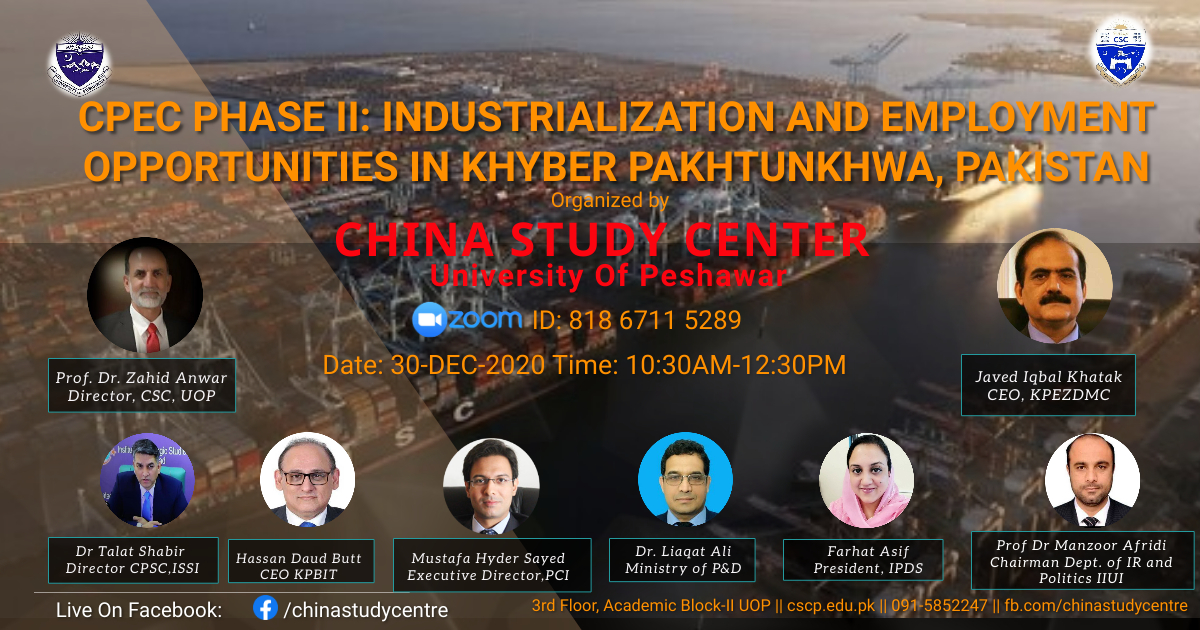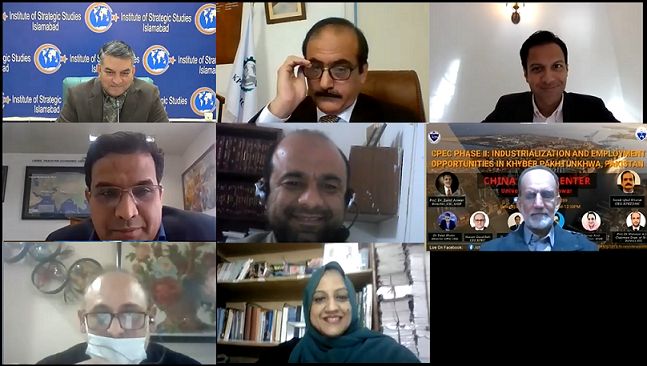Back to Gallery
CPEC: INDUSTRIALIZATION & EMPLOYMENT OPPORTUNITIES IN KHYBER PAKHTUNKHWA, PAKISTAN
China Study Center, University of Peshawar has organized a Webinar titled ‘CPEC Phase II: Industrialization and Employment Opportunities in Khyber Pakhtunkhwa, Pakistan` on 30th December 2020. Prof Dr Zahid Anwar Director China Study Center University of Peshawar in his welcome address said that China launched Belt and Road Initiative (BRI) in 2013which is a Mammoth project of regional economic connectivity and prosperity. BRI is 21st century Silk Road. Belt and Road Initiative has six economic corridors, one among those important economic corridors is called China Pakistan Economic Corridor (CPEC). CPEC is a collection of Pakistan and China joint projects in the sectors of energy, infrastructure and telecommunications. CPEC was started in 2015 and will complete in 2030. 32 early harvest projects of CPEC have been completed. Over 85000 Pakistani have got employment in CPEC projects. More than 28000 Pakistani students are now studying in China. In 2020 the second phase of China Pakistan Economic Corridor has started. The second phase of CPEC will be focused on industrialization. It will galvanize economic and employment opportunities in Pakistan. Though COVID has devastated global economy nevertheless the resilient humanity will bounce back. Today distinguished scholars will analyze the measures adopted for completion of CPEC projects in phase II. Gwadar deep port provides warm water access to Russia Central Asia, Afghanistan and China. Rashakai Special Economic zone will bring revolution in industrial development in Khyber Pakhtunkhwa, Khattar, and Mohmand marble city and Peshawar to Kabul motorway will enhance regional integration and economic development.
Hasan Daud Butt, CEO, KPBIT in his presentation said that the CPEC has entered crucial second phase in which cooperation in industrial development and agriculture sector improvement is vital and it has the potential to transform Pakistan`s economy and make it a regional trade hub. The industrial cooperation which commence in 2016 has gone through various stages and today Rashakai , Faisalabad and Dhabheji Special Economic Zones (SEZs) are all set for development.
Sayed Mustafa Hayder, Executive Director, Pakistan China Institute said that materializing special economic zone should be a provincial led effort, after 18th amendment the provinces are fully empowered. When foreign companies come for investment they are not clear where to go so better coordination is required and One Window Operation facility should be provided to those who want to invest. China is relocating its industries. The initiative of attracting investment should remain with KP Government, KPEZDMC and KPBIT.
Dr. Talat Shabbir, Director China-Pakistan Study Centre at Institute of Strategic Studies Islamabad in his speech emphasized the need of ensuring employment opportunities in the province and learning from Chinese experience. He suggested that efforts must be made to encourage private sector investment in the Special Economic Zones (SEZs) while regulatory procedures should also be streamlined.
Javed Iqbal Khattak CEO, KPEZDMC said that as CPEC is a flagship project of Belt and Road Initiative so is Rashakai Special Economic Zone (RSEZ) a flagship project of CPEC Special Economic Zones. RSEZ is spread over one thousand acres areas. We have received 1700 applications from different investors which is a very encouraging development for us. RSEZ will boost economic recovery and exports of this region. We are opening Jaluzai, Nowshehra, Ghazi, Chitral for investment. From RSEZ 2 to 3 lacs people in the province will get employment.
Dr Liaqat Ali Shah from Ministry of Planning in his speech said that economic transformation is taking place in China. China will relocate some its industries like cement, steel etc. We are marketing our SEZs. Pakistan can get benefit from this transformation. We have identified 52 products where we are globally competitive.
Ms Farhat Asif , President IPDS in her presentation said that we should focus more on materializing the existing SEZs.138 countries have joined BRI. BRI and CPEC are connecting Pakistan to GVC (Global value Chain). We need political stability to develop our economy.
Dr Manzoor Afridi, head of Politics and IR, IIUI said that SEZs played pivotal role in the economic development of China. Pakistan has 9 SEZs under CPEC which are established to follow the Chinese successful experience. KP can provide good environment to Chinese investors. He said that according to Chief Minister Mahmood Khan, RSEZ will provide 2 lac jobs.
By
Prof Dr Zahid Anwar
Director, China Study Center
University of Peshawar, PAKISTAN
csc@uop.edu.pk


